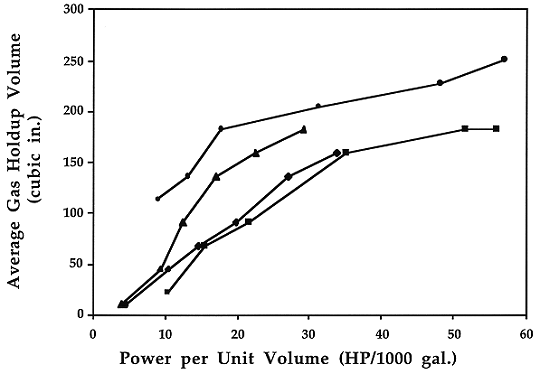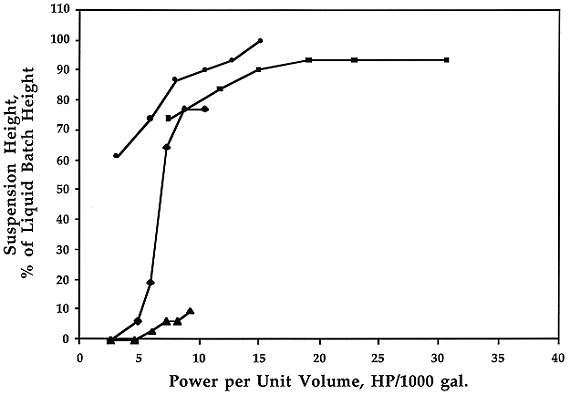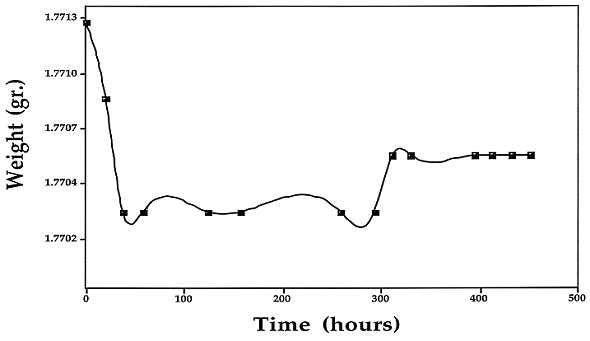
Fig. 1. Gas holdup volume versus
normalized power for candidate agitator systems.

Fig. 2. Solids suspension height
versus normalized power for candidate agitation systems.
Patrick M. Dhooge, Scott D. Goldblatt, James E. Moslander,
Donald T. Robertson, Terry W. Rogers, and Joseph A. Zigmond
Delphi
Research, Inc.
Albuquerque, NM.
ABSTRACT
DETOXSM, a catalyzed chemical oxidation process, is under development for treatment of hazardous and mixed wastes at Department of Energy sites. To support this effort, developmental engineering studies have been performed for aspects of the process to help ensure safe and effective operation. Subscale agitation studies have been performed to identify a suitable mixing head and speed for the primary reaction vessel agitator. Mechanisms for feeding solid waste materials to the primary reaction vessel have been investigated. Filtration to remove solidified process residue, and the use of various filtration aids, has been studied. Extended compatibility studies on the materials of construction have been performed. Due to a change to Rocky Flats Environmental Technology Site (RFETS) for the mixed waste portion of the demonstration, types of wastes suitable and appropriate for treatment at RFETS had to be chosen. A prototype unit has been fabricated and will be demonstrated on hazardous and mixed wastes at Savannah River Site (SRS) and RFETS during 1997 and 1998. The unit is in shakedown testing at present. Data validation and an engineering evaluation will be performed during the demonstration.
INTRODUCTION
The DETOXSM process uses oxidation by ferric iron in an aqueous solution to destroy organic compounds and keep toxic metals in the ionized state in solution. Due to the relatively low operating temperature (A 200°C) of the process, it does not produce the toxic organic by-products and volatilized metals found in the outputs of high temperature processes such as incineration. The gaseous emissions from the process are of low volume and easily controlled. The process is tolerant of the water content of wastes, and can co-process aqueous and organic wastes. It is not at this point developed for application to soils or other high inorganic content wastes.
Due to the advantages the process provides in low emissions and ability to treat a variety of waste types, including wastes and remediates containing multiple hazardous components, the Department of Energy Office of Science and Technology has funded demonstration of the process on low level mixed wastes through the Industrial Assistance Program at Morgantown Energy Technology Center.
The object of the demonstration is to provide verifiable data that can be used to allow future permitting and use for mixed, hazardous, and low level waste treatment.
ENGINEERING STUDIES
Agitation
One of the most vital engineering parameters for the process is the effectiveness of agitation. The DETOXSM reaction vessel needs to have a stirrer arrangement which is not overly complex, but which will effectively mix a wide variety of solids and liquids with the DETOXSM process solution as well as ensuring good gas dispersion in the solution.
A literature and vendor survey was conducted to identify candidate agitators that would have the desired mixing capabilities. Ten candidate stirrer and baffling arrangements were tested for mixing efficiency. The candidates were evaluated for gas holdup, ability to disperse immiscible liquids and solids in water, and power use. Of the stirrer/baffle arrangements tested, the one with the best overall mixing was chosen for the prototype unit. Evaluation parameters versus power use for some of the stirrer/baffle arrangements are shown in Figs. 1 and 2.

Fig. 1. Gas holdup volume versus
normalized power for candidate agitator systems.

Fig. 2. Solids suspension height
versus normalized power for candidate agitation systems.
Power curves for the stirring arrangements indicate that 6 - 7 kW (8 - 9 HP) per 1000. gal. of solution is sufficient for the reaction vessel agitator.
The three best candidate agitator arrangements were bench-tested in oxidation of a liquid and two solids. Two arrangements gave nearly the same rate of carbon dioxide production, but one was much simpler in concept.
Solids Feeding
Many mixed and radioactive wastes are in solid form. Feeding solids to a pressurized reaction vessel is more difficult than feeding liquids. Bench scale tests had used an airlock arrangement, but an airlock is impractical for feeding large amounts of solids to a pressurized vessel. A mechanism needed to be identified that was rugged in its ability to handle solids, simple and reliable in its ability to feed the solids to a pressurized reaction vessel, and did not allow escape of gases from the reaction vessel during feeding operations.
A mixture of shredded paper, plastics, and rubber was used as a surrogate solid feed. The proportions of these materials were as specified by Rocky Flats Environmental Technology Site (RFETS) for solid combustible waste. The solid materials were not pre-wetted, nor did they contain any surrogate hazardous materials. The materials were shredded to simulate the action of a standard commercial shredder being used to reduce particle size and homogenize the waste before it is fed to the process. Maximum feed rate for the tests was 25. kg (dry weight, organic material)/hr.
Six solids feed mechanisms were tested for their ability to reliably feed solids. All mechanisms were used to feed solids into a vessel pressurized to 700. kPa (110 psi). The mechanisms were evaluated for their ability to reliably feed the solids into the pressurized vessel at a rate of up to 25. kg (dry weight, organic material)/hr with no gaseous blow-by. The best solids feed arrangement was chosen based on the results from these studies.
Filtration
Wastes containing inert materials or which produce solids when treated require a filtration system to remove these solids from the process solution. In addition, the process solution will periodically accumulate enough dissolved toxic metals or radionuclides that it will be desirable to solidify it for stabilization and ultimate disposal. The solidified process solution will need to be isolated by filtration as well.
Literature and vendor sources were investigated to identify a desirable filtration system. The ideal system would have materials of construction compatible with the process solution, be capable of filtering micron-sized particles from the process solution, deliver solids into a drum or other suitable container without manual handling, be rinsable, and preferably be automated. Several candidate systems were identified, and the list was reduced to one type based on anticipated performance and price.
Subscale filtration studies identified the filtration rate for a DETOXSM process solution loaded with approximately 10.% fine (2. - 10. µm) particulate. The rate at which rinse solution passed through the resulting filter cake was also measured. A filter system for the demonstration unit was sized based on the anticipated amount of inert and produced solids and the measured filtration/rinse rates. This system was sized for a waste that contains or produces an inert solid equal to about 60.% by weight of the waste.
Subsequent to the filter sizing, studies were conducted on the effects of soluble inorganic salts loading and filtration aids on the solids filtration rate for the process solution through a chosen filter medium. Some results of these studies are shown in Fig. 3.

Fig. 3. Process solution residue
removed versus filtration time for various conditions.
Materials Compatibility
Previously conducted compatibility testing showed very low corrosion rates for the demonstration unit's materials of construction under the conditions of the DETOXSM process. In addition to the formal testing, a bench scale reaction vessel had been used for over 400. hours in the presence of DETOXSM solution at operating temperatures with no visible signs of corrosion.
However, it was known that the DETOXSM process solution would accumulate a variety of dissolved inorganic materials, including sulfate, phosphate, fluoride, and metal ions, during waste treatment. There was concern that buildup of soluble inorganics in the process solution could cause corrosion that was not seen in the presence of the pure DETOXSM solution. Therefore, further tests were conducted with DETOXSM solution saturated with a variety of contaminant ions.
As in previous compatibility tests, coupons of the materials of construction were weighed to the nearest 0.1 mg and placed into glass-or fluorocarbon-lined, sealed test vessels in the presence of the DETOXSM solution. Typically the coupons were placed so that roughly half the coupon was below the solution surface and half was in the gas space above the process solution. The test vessels were heated to the operating temperature of the process and maintained at that temperature for a period of time. Then, the vessels were cooled, unsealed, and the coupons visually inspected and weighed.
The corrosion rate for the materials of construction remained low in the inorganic salt-saturated DETOXSM solution. A typical corrosion rate curve is shown in Fig. 4. After an initial period the surface of this material apparently passivates, so that very little additional corrosion occurs. The rate of corrosion even before passivation is low.

Fig. 4. Coupon weight versus exposure
time for prototype material of construction.
WASTE SELECTION AT RFETS
The waste surrogate selection for the portion of the demonstration at SRS was given in last year's paper (1).
Due to a site change from Weldon Spring Site Remedial Action Project (WSSRAP) to RFETS for the mixed waste treatment phase of the demonstration project, the selection of mixed wastes to be treated has been altered. The change in waste types does not affect the validity of the demonstration, and may even make the results more applicable to other DOE sites.
Waste types for the demonstration have been chosen based on a variety of factors.
Wastes that have been chosen for demonstration treatment at RFETS are oils, solvents, solid combustibles, filter materials, contaminated insulation, paints and paint sludges, solidified organics, PCB-contaminated fluids, and excess chemicals. Mostly surrogates will be tested at SRS, while all of the wastes to be treated at RFETS are mixed wastes containing low levels of uranium and /or plutonium.
The variety of materials to be treated should establish a wide range of application for the process, including materials that have high inorganic content, and PCB-contaminated materials. At the same time, a significant volume of RFETS waste will be treated during the demonstration.
DEMONSTRATION PROTOTYPE
The demonstration prototype unit has an estimated throughput of 25. kg (dry weight, organic material)/hr. Throughput will be greater for wastes with significant water or inert solids content, since these materials do not have to be oxidized.
The prototype is a transportable modular design consisting of two process modules, an oil heating/cooling module, an oil chilling module, a motor control center, and a control/laboratory trailer. A supply of oxygen gas is typically provided by vaporization from a cryogenic tank of liquid oxygen.
Liquid or solid wastes can be treated in the prototype unit. Liquid wastes are introduced into the primary reaction vessel with a diaphragm metering pump. Solid wastes are shredded, slurried in water, and pumped into the primary reaction vessel.
Product gases are monitored for HCl and total gaseous organic compounds, and passed through an activated carbon bed and HEAP filter before release.
Product water from the process is condensed, neutralized, sparged, and pumped into an effluent storage tank for testing before being sent to wastewater treatment or disposal.
Inert and produced solids can be filtered from the DETOXSM process solution during waste treatment, and are automatically delivered into drums for stabilization and disposal.
SHAKEDOWN TESTING
The demonstration prototype is undergoing shakedown testing at SRS's Multipurpose Pilot Plant Campus (formerly the TNX facility). Shakedown testing involves a functional evaluation of the prototype, followed by separate trial oxidations of mineral oil and a mixture of combustible solids.
Shakedown testing will evaluate the functionality and correctness of the prototype unit systems and operating procedures using non-toxic organic feed materials. The control loops will be fine-tuned, and safety, sampling, and environmental compliance procedures practiced to test their appropriateness and give personnel experience with the procedures. Operating parameters for the prototype will be adjusted to attempt to achieve good destruction efficiencies when surrogate waste treatment begins.
The shakedown period will allow any obviously faulty components and/or procedures to be identified and corrected before treatment of surrogate wastes begins, and will give the operating technicians a period to familiarize themselves with all aspects of prototype operation.
DATA VALIDATION AND ENGINEERING EVALUATION
Experimental data from the demonstration, and in particular analytical data on emissions from the prototype unit, will be validated by an independent third party to help ensure that the data has been collected in a proper manner for acceptance by environmental regulators and potential users of the technology.
The data validator will review the Demonstration Test Plan and the Sampling and Analysis Plan, and will prepare a Validation Plan for the demonstration. Input from the Primary Stakeholders and regulatory representatives will aid in developing a test scheme that generates appropriate and verifiable data to support subsequent application of the process. The validator will audit the prototype operations, sample analysis, data management, and data interpretation to verify the results obtained. During the later stages of the demonstration, an engineering assessment of the DETOXSM technology will be conducted to determine the cost and applicability of the process. A baseline commercial design will be prepared, with cost and sensitivity analyses based on system and feed parameters.
The engineering evaluation will use the determined destruction efficiencies, throughputs, and emissions for the waste types treated in the demonstration, in addition to information on capital cost, maintenance cost, labor cost, utilities use, operating materials cost, and stream factor (i.e., the percentage of time the unit can expect to be operating) to determine unit sizes and costs for typical commercial applications.
The baseline commercial design will incorporate any needed improvements that have resulted from the demonstration testing, and process improvements that may have occurred during the period of the demonstration. Sensitivity analysis will help identify the best operating regimens, and the waste types and volumes to target in commercial application.
ACKNOWLEDGMENTS
We would like to thank EM-50, and in particular Clyde Frank, Paul Hart, William Schutte, James Taylor, and Allison Johnson, for their support and assistance in making this project possible. We would like to acknowledge the excellent assistance and support provided by METC and the CORs assigned to the project, V.J. Kothari, James Westhusing, Keith Westhoff, and our current COR, William Huber. We would also like to acknowledge the help and assistance we have obtained from the DOE and M&O personnel at Savannah River Site and Rocky Flats Environmental Technology Site, especially Howard Pope, George Mishra, Beverly Skwarek, Steve Sheetz, Mark Fachada, David Boyce, Frank Lustig, Gary Huffman, Linda Bateman, Jeff Petersell, Charles Brown, and Beth Fabrizio. This work is being performed under the review of the Department of Energy's Mixed Waste Focus Area.
REFERENCES